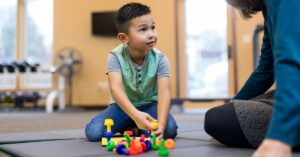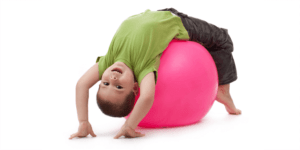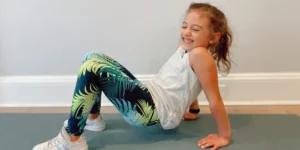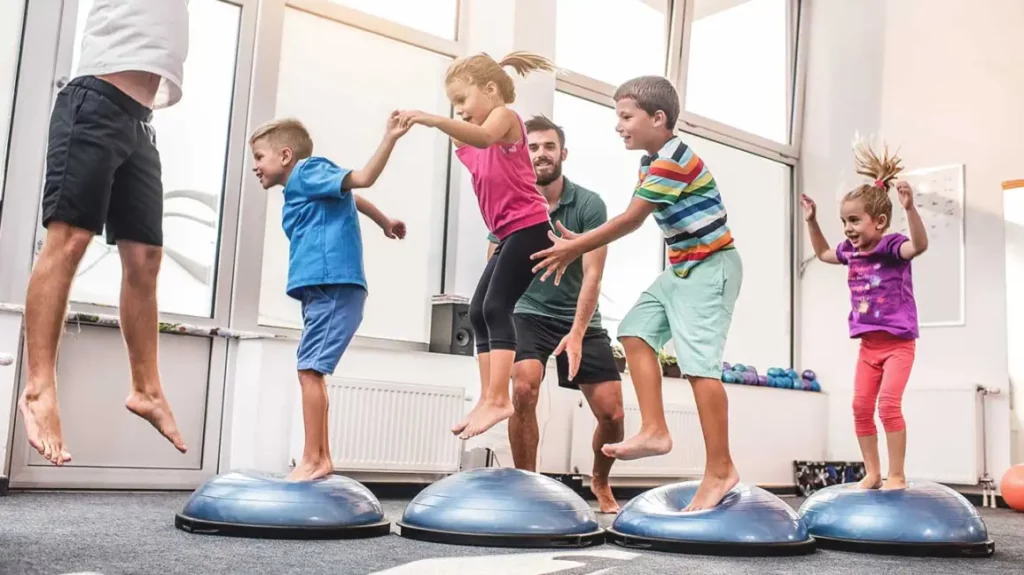If you have a child who needs physical therapy, you want to make sure that they are getting the best possible care. That means ensuring that they are doing the right exercises to improve their health and mobility. In this blog post, we will discuss the three best types of pediatric physical therapy exercises. These exercises can help your child recover from an injury or illness, or simply improve their overall fitness level.
Contents
3 Types Of Pediatric Physical Therapy Exercises
 Pediatric physical therapy exercises are described as a type of motor activity that helps in the development and restoration of movement. It also helps to improve a child’s functional ability, strength, range of motion, and gross/fine motor skills.
Pediatric physical therapy exercises are described as a type of motor activity that helps in the development and restoration of movement. It also helps to improve a child’s functional ability, strength, range of motion, and gross/fine motor skills.
This is specific to the rehabilitation of children who have been diagnosed with conditions such as cerebral palsy, down syndrome, developmental delays, and muscle weakness. The type and intensity of exercises will vary depending on the child’s age, condition, and functional level.
There are many different types of pediatric physical therapy exercises available, and those are divided into three main categories:
- Core Strengthening Exercises
- Motor Skills Exercises
- Mobility Exercises
Let’s discuss these different types of exercises in further detail and provide some examples of exercises:
Core Strengthening Exercises
The main purpose of core strengthening exercises is to improve a child’s trunk control and stability. This helps to prepare the child’s body for sitting, standing, and walking. These exercises also help to improve a child’s balance and coordination.
Some examples of core strengthening exercises include:
Prone Plank
This exercise helps to improve a child’s trunk control and stability. The child starts by lying on their stomach with their elbows and forearms resting on the ground. They should then lift their hips off the ground, keeping their back and legs straight.
Side Plank
This exercise is similar to the prone plank, but it is performed on the child’s side. This helps to improve trunk control and stability, as well as balance.
Bridge
This exercise helps to improve trunk control, stability, and strength. The child starts by lying on their back with their knees bent and feet flat on the ground. They then lift their hips off the ground, keeping their back straight.
Superman
It is an excellent exercise to improve a child’s trunk control and stability. The child starts by lying on their stomach with their arms and legs extended. They then lift their arms, legs, and head off the ground.
Clamshells
This type of exercise is performed lying on the child’s side. It helps to improve hip stability and control. The child starts by lying on their side with their knees bent and feet together. They then lift their top knee while keeping their feet touching.
Motor Skills Exercises
 The main purpose of motor skills exercises is to improve a child’s ability to perform tasks that require coordination and sequencing, such as writing, cutting with scissors, and tying shoelaces.
The main purpose of motor skills exercises is to improve a child’s ability to perform tasks that require coordination and sequencing, such as writing, cutting with scissors, and tying shoelaces.
- Scissor skills – Have your child practice cutting along a line with a pair of child-safe scissors. Start with thick lines and work your way up to thinner ones.
- Buttoning – Buttoning and unbuttoning buttons is a great way to improve fine motor skills. Use buttons of different sizes to make it more challenging.
- Beading – String beads onto a piece of string is another great way to improve fine motor skills and eye-hand coordination.
- Drawing – Drawing shapes, lines, and other simple pictures is a great way for children to practice their fine motor skills.
- Cutting with scissors – As children get better at cutting with scissors, they can try cutting out simple shapes from paper.
- Tying shoelaces – Tying shoelaces is a great way to improve coordination and sequencing skills. Start with the basic “bunny ear” method and then progress to the “loop” method.
- Building with blocks – Building towers, houses, or other structures with blocks is a great way to improve problem-solving skills and eye-hand coordination.
- Playing catch – Playing catch is a great way to improve hand-eye coordination.
These are just a few ideas for motor skills exercises. There are many more that can be found online or in parenting books.
Sensory Processing Exercises
Sensory processing is the ability to take in information from the environment and make sense of it. This can be a challenge for some children, especially if they have sensory processing disorders. It can make it difficult to process and respond to information from the senses.
There are many sensory processing exercises that can help children with this disorder. These exercises can help improve their ability to take in information from the environment and make sense of it.
- Auditory processing: This exercise involves listening to different sounds and trying to identify them. This can help children with auditory processing disorders improve their ability to process and respond to sound.
- Visual processing: This exercise involves looking at different objects and trying to identify them. This can help children with visual processing disorders improve their ability to process and respond to visual information.
- Tactile processing: This exercise involves touching different objects and trying to identify them. This can help children with tactile processing disorders improve their ability to process and respond to information from touch.
- Proprioceptive processing: This exercise involves moving the body in different ways and trying to feel the movement. This can help children with proprioceptive processing disorders improve their ability to process and respond to information from movement.
- Vestibular processing: This exercise involves moving the head in different directions and trying to feel the movement. This can help children with vestibular processing disorders improve their ability to process and respond to information from movement.
These are just some of the many exercises that can help children with sensory processing disorders. These exercises can help improve their ability to take in information from the environment and make sense of it.
All in all, these are the three most common types of pediatric physical therapy exercises. And each type can help your child in a different way! If you think your child might benefit from any of these exercises, be sure to talk to their doctor or physical therapist. They can help you find the right exercises for your child and create a personalized plan!
What Are Some Common Exercises For Kids?
 A pediatric physical therapist will often incorporate play into therapy sessions to make the exercises more fun for kids. Here are 5 common exercises that may be used to help improve a child’s strength, flexibility, endurance, and coordination:
A pediatric physical therapist will often incorporate play into therapy sessions to make the exercises more fun for kids. Here are 5 common exercises that may be used to help improve a child’s strength, flexibility, endurance, and coordination:
Bouncing on a trampoline
This is a great way to get kids moving and improve their balance and coordination. It can also help build strength in the legs. To do this exercise, have your child stand on a trampoline and bounce up and down. This will also help improve their balance and coordination.
Riding a bike
It is a type of aerobic exercise that helps improve the child’s endurance. It can also help build strength in the legs. This will also help improve the child’s coordination. To do this simple exercise, have the child ride a bike around the neighborhood or in the park.
Climbing stairs
Generally, it is recommended that children with cerebral palsy avoid stairs because of the risk of falling. However, some exercises that involve climbing stairs can be beneficial for children with cerebral palsy. These exercises can help to improve strength, coordination, and balance. In fact, a study of children found that those who participated in a stair-climbing program had improved muscle control and coordination, as well as increased strength and endurance.
Running
Running can be a great physical therapy exercise for kids. It can help them improve their coordination and motor skills while also getting some exercise. Here are a few tips to help your child get the most out of running:
- Start slowly – don’t try to go too fast at first. Let your child build up their endurance gradually.
- Mix it up – running doesn’t have to be boring! Try incorporating some games into your child’s running routine to keep them engaged.
- Be safe – make sure your child is wearing proper footwear and clothing to avoid injuries.
- Have fun – Encourage your child to enjoy running by making it a fun and positive experience.
Dancing
Finally, dancing can be a great physical therapy exercise for kids. It is a fun way to help them work on their coordination and balance while also getting some good cardio in. Just make sure that you start slowly and let your child lead the way. As they get more comfortable, they can start to pick up the pace and really get their heart rate going.
Overall, these are just a few examples of pediatric physical therapy exercises that you can do at home with your child. Of course, it is always best to consult with a physical therapist before starting any new exercise routine. They can help tailor a program specifically for your child’s needs and make sure that they are doing the exercises correctly.
How Many Times A Week Should You Do Exercises?
 Many people ask how often they should do their physical therapy exercises. The answer to this question is that it depends on each individual’s situation. For example, if you are going through rehabilitation after an injury, you will likely have to do your exercises more frequently than someone who is trying to prevent an injury from happening in the first place.
Many people ask how often they should do their physical therapy exercises. The answer to this question is that it depends on each individual’s situation. For example, if you are going through rehabilitation after an injury, you will likely have to do your exercises more frequently than someone who is trying to prevent an injury from happening in the first place.
That being said, there are some general guidelines that you can follow. For most people, it is recommended that you do your physical therapy exercises 3-5 times per week. This will help to ensure that you are getting the most benefit from your exercises and achieving your goals.
If you find that you are struggling to fit your exercises into your schedule, there are a few things that you can do to make it easier.
- First, try to break up your exercises into smaller sessions throughout the day. For example, instead of doing all of your exercises at once, you could do a few exercises in the morning, a few in the afternoon, and a few at night.
- Second, try to find exercises that you can do while you are doing other activities. For example, if you are watching TV, you could do some stretches or light weightlifting during the commercials.
- Finally, try to enlist the help of a friend or family member. Having someone else to do your physical therapy exercises with can make it more fun and help to motivate you.
By following these tips, you can make sure that you are getting the most out of your physical therapy exercises and achieving your goals. It is important to remember that everyone is different and that you should listen to your body to figure out what works best for you.
If you have any questions or concerns about your physical therapy exercises, be sure to talk to your doctor or physical therapist.
Conclusion
In a nutshell, pediatric physical therapy exercises are a great way to help your child improve their physical condition and quality of life. With the help of a qualified therapist, they can often be tailored specifically to your child’s needs and abilities, providing them with the most benefit. If you think your child might benefit from physical therapy, don’t hesitate to talk to their doctor or another healthcare professional.
Physical Therapy has always been proven to help patients recover from pain. Hence, if you’re experiencing Back pain, Shoulder pain, Knee pain, Neck pain, Elbow pain, Hip pain, or Arthritis pain, a physical therapist at MantraCare can help: Book a physiotherapy session.


